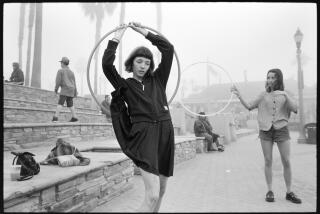The Art Photography of Dance : DANCE AND PHOTOGRAPHY <i> by William A. Ewing (Henry Holt: $50; 240 pp.) </i>
More than a historical look at dance photography, this book is a compendium of dance photographs as an art form unto themselves. Not merely a nostalgic collection of famous dancers and choreographers for the balletomane, “Dance and Photography” looks at each photograph as a separate image that speaks clearly for itself. It’s a wonderful collection and it’s especially nice because most of the photos haven’t been reproduced elsewhere, giving the whole volume an appealing freshness.
Dance photography holds a special place in the annals of art, as for most of dance history, all record of the performers and performances are lost except for mostly subjective faded, elderly recollections and drawings. Once photography was available it became an objective record (other than drawings) of a specific performance and/or performer. And the art of dance, ephemeral and gossamer like many of its heroines, is so aptly suited to the instant-it-happens use of a camera. Even though video is now the ultimate tool for recording a dance, nothing quite catches the spirit, the essence, the sheer drama of movement the way a photograph does, particularly the graphic surface of a black-and-white print.
The book is divided into sections that are arbitrary and not necessarily definitive. After the first section, “Invention,” which examines the beginnings of dance photography, the subsequent sections tend to blur harmlessly into a symphony of images. All photographers have an “Independent Eye”; any one of these photographs can be termed a “Tour de Force” and/or a record of an “Icon and Idol.”
Ewing, however, has unearthed some moving and eccentric pictures, like the two of opera dancers attributed to Edgar Degas, the portrait of George Balanchine holding a hammer and a brace and bit by George Platt Lynes, and the wonderful abandon of the “Isadorables” and Ruth St. Denis at the beach in Santa Monica, which in turn, is echoed by a similar print of Marie Rambert dancing in a garden. The best photos are the candid shots, mirrors if you will, of performances, whether they be in the street, a dance studio or on stage. These speak the most succinctly of dance and dancing. And, because of their transience, they stand alone as artistic visions: each image a true collaboration between subject and photographer.
They also make this book one of the most heart-and-soul stirring records of the spirit of dance.
More to Read
The biggest entertainment stories
Get our big stories about Hollywood, film, television, music, arts, culture and more right in your inbox as soon as they publish.
You may occasionally receive promotional content from the Los Angeles Times.










